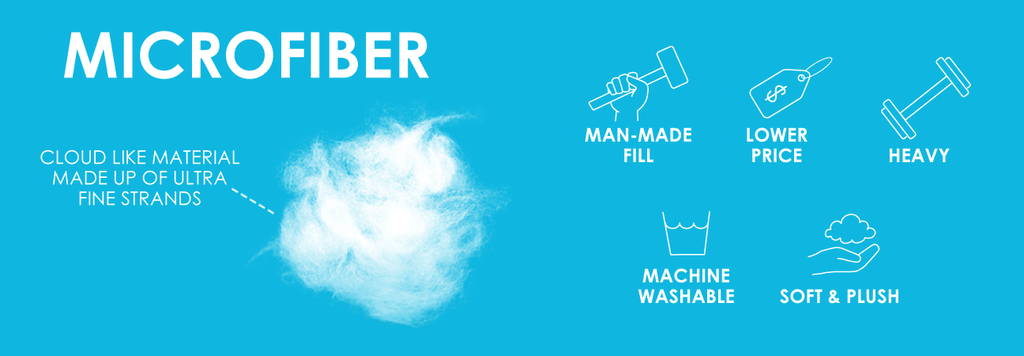What is down?
Down is a natural material from either duck or geese. The quality of down is indicated by its loft, or fluffiness, which is calculated by the amount of space one cubic ounce of down can fill. Good quality down comes from birds that have reached their full maturity, and therefore possess down with the highest loft.
Down is often regarded as the Cadillac of duvet materials, coveted for its softness and superb insulating properties. Down is such a great insulator, that just a small amount provides a great deal of warmth. This makes down duvets very light on the body.
Because of its scarcity, quality and its long maturation process, down is a pricey purchase. The higher the loft of down, the more expensive it becomes.
The warmth that down provides with minimal quantity is matched by no other fill. One ounce of down is warmer than one ounce of Microfiber. Down Alternative duvets can provide just as much warmth, but much more fill is required. This makes synthetic Microfiber duvets heavier on the body.
Down has a higher fill power than microfiber, which means it can provide more warmth with less weight. Fill power refers to the amount of space one ounce of down can fill, and it ranges from 500 to 900. Microfiber duvets usually have a lower fill power, which makes them heavier and less insulating.
Down is more breathable than microfiber, as it allows air to circulate through the feathers. This helps to regulate temperature and prevent overheating. Microfiber is less breathable, as it traps more heat and moisture, which can make it uncomfortable for some sleepers.
Down is more durable than microfiber, as it can last for decades if properly cared for. Down can also retain its loft and shape better than microfiber, which can flatten and clump over time. Microfiber is less durable, as it can lose its softness and fluffiness after repeated washing and drying.
Down is more expensive than microfiber, as it is a scarce and high-quality material. Down also requires more ethical and environmental considerations, as it involves animal welfare and harvesting practices. Microfiber is cheaper, as it is widely available and mass-produced. Microfiber is also more suitable for animal-conscious and vegan shoppers.
Down is more allergenic than microfiber, as it can harbor dust mites, mold, and other allergens that can trigger allergic reactions. Down also requires special cleaning methods, such as dry cleaning or professional washing, to remove these allergens. Microfiber is hypoallergenic, as it is resistant to dust mites, mold, and bacteria. Microfiber can also be easily washed at home with regular detergent and water.
Microfiber Fill
Microfiber is soft like down, but slightly different in feel. Down traps a lot of air, so it can be compressed significantly with applied pressure. Microfiber is denser, trapping less air, for more of a plush feel. (If down is cotton candy, microfiber is marshmallow!)
Our microfiber fill offers excellent thermal insulation and a superior down alternative. Made of premium polyester microfibers, this feather-like fiberfill is suitable for use in outerwear, pillows, bedding, etc.
Cluster Fiber Fill
Cluster fiber fill is a synthetic filling made of small balls of polyester fibers. It has various uses in the garments, toys, bedding, and home décor industries. It is soft, fluffy, breathable, resilient, and hypoallergenic. It is a good alternative to down, as it does not clump or bunch and has a high filling power. Cluster fiber fill is also washable and durable, making it suitable for products that are aimed at allergy sufferers. However, it may not be as durable or breathable as natural fillings like down or feather.
Cluster fibre has a lightweight balled form, allowing air to pass freely through the fibre, maintaining its plump form without clumping or matting even through repeated use and washing
- Cluster fibre: the vegan way to fluff up your life.
- No feathers, no wool, no problem. Cluster fibre is the ultimate cruelty-free comfort.
- Cluster fibre: soft, breathable, and 100% animal-free. The filling that fills your heart.
According to the Furniture and Furnishings (Fire Safety) Regulations 1988 (as amended in 1989, 1993 and 2010), cluster fibre filling must meet specified ignition requirements, as well as other criteria, to be used for domestic upholstered furniture in the UK. Cluster fibre filling is considered a non-foam filling material, and it must pass the relevant tests in Schedule 2 Part I of the Regulations. These tests involve exposing the filling material to a smouldering cigarette and a butane flame, and measuring the extent of flaming, smouldering, and charring. Cluster fibre filling that complies with these requirements can be labelled as “FILLING MATERIAL(S) MEETS THE FLAMMABILITY REQUIREMENTS OF THE FURNITURE AND FURNISHINGS (FIRE) (SAFETY) REGULATIONS 1988” or “FILLING MATERIAL(S) MEETS SCHEDULE 2 PART I”.
The flammability requirements of the furniture and furnishings (fire) (safety) regulations for domestic use are UK law and may differ from other countries. For example, in the European Union, there is no harmonised standard for furniture fire safety, and different member states may have their own national regulations or voluntary schemes. Therefore, cluster fibre filling that complies with the UK regulations may not necessarily comply with the regulations of other countries, and vice versa. It is advisable to check the specific requirements of the intended market before supplying or purchasing upholstered furniture with cluster fibre filling.








